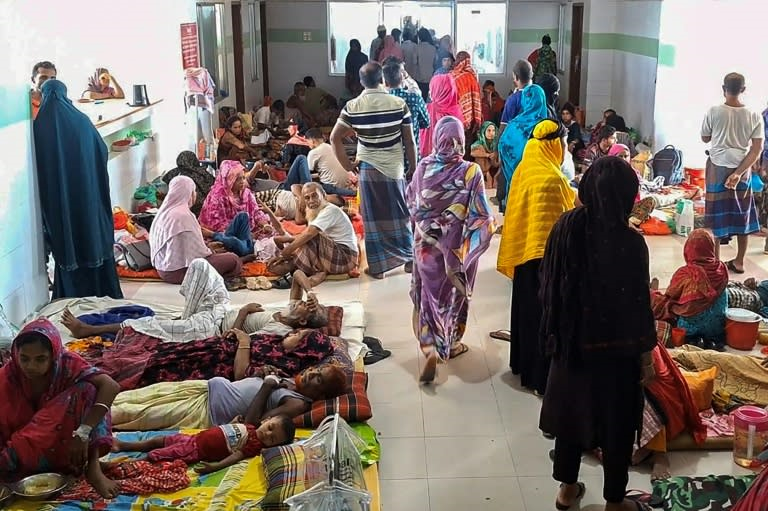Dengue fever, a debilitating and potentially fatal mosquito-borne viral disease, is escalating into an alarming public health crisis in Bangladesh, particularly impacting its vulnerable coastal districts.
Historically, these areas rarely experienced significant outbreaks of dengue. However, a stark and concerning shift is now evident. Hospitals in the affected regions are so overwhelmed by the sheer volume of patients suffering from the virus that many are forced to receive treatment while lying on the floor, a grim indicator of the crisis’s severity.
Experts attribute this unprecedented surge to the insidious effects of climate change, which is driving increasingly erratic weather patterns across the globe. In Bangladesh’s wider delta region, where the mighty Brahmaputra and Ganges rivers converge and meet the sea, a critical lack of clean drinking water is pinpointed as a primary catalyst for the escalating dengue cases.
This dire situation is not merely a public health challenge; it is a profound human tragedy, as families grapple with the devastating consequences of the disease. The story of Rakibul Islam Rajan, whose two-year-old daughter continues to search for her mother, Azmeri Mona Lisa Zareen, after she succumbed to dengue in early June in the southern Barisal region, painfully illustrates the personal cost of this growing epidemic.
The Human Cost: Loss and Overwhelmed Healthcare
The surge in dengue cases has led to tragic fatalities and pushed the healthcare system in Barisal to its breaking point.
A Family’s Irreparable Loss
The human toll of the escalating dengue crisis in Bangladesh is starkly illustrated by individual tragedies. In the southern region of Barisal, Rakibul Islam Rajan, a 31-year-old, is grappling with an unimaginable loss: the death of his 28-year-old wife, Azmeri Mona Lisa Zareen, due to dengue fever in early June. Rajan recounts the harrowing progression of her illness, emphasizing the speed and severity of the virus. “Zareen developed high fever,” he shared, describing the initial, common symptom of dengue.
The fever quickly intensified, leading to critical complications. “Her blood pressure collapsed,” a dangerous sign of severe dengue, often indicating plasma leakage and organ dysfunction. Tragically, her condition rapidly deteriorated further, culminating in respiratory failure: “and then she couldn’t breathe.”
The profound impact of this loss extends beyond Rajan to their young daughter, who innocently embodies the ongoing grief. “Our daughter keeps searching for her from one room to another,” Rajan lamented, highlighting the child’s desperate quest for her mother’s presence. This heartbreaking scenario underscores the devastating, immediate consequences of dengue, particularly when it progresses to its severe forms.
In the worst cases of dengue, the intense viral fevers can trigger life-threatening symptoms, including internal bleeding or bleeding from the mouth and nose, conditions that rapidly overwhelm the body’s systems and often prove fatal without immediate and intensive medical intervention. Zareen’s case is a painful example of the severe form of the disease, known as dengue hemorrhagic fever, which can lead to shock and death.
Barisal’s Alarming Caseload and Hospital Strain
The Barisal region is at the epicenter of Bangladesh’s current dengue crisis. Data from the Institute of Epidemiology, Disease Control and Research (IEDCR) reveals a distressing concentration of cases in this southern area. Barisal alone has recorded nearly half of the 7,500 dengue cases identified across the entirety of Bangladesh this year.
This disproportionate burden highlights a significant localized outbreak. Furthermore, out of the 31 dengue-related deaths recorded nationwide across a population of approximately 170 million people, five have tragically occurred in Barisal this year. While these numbers are currently far below the catastrophic outbreak of 2023, which saw more than 1,700 deaths and over 200,000 infections across the South Asian nation, the rapid acceleration of cases in Barisal raises grave concerns.
The sheer volume of patients has pushed the healthcare infrastructure in the region to its absolute limits. Shyamol Krishna Mondal, the health chief for Barisal, described the situation as “the worst we’ve seen” in the area. He cited the example of Barguna’s 250-bed public hospital, which was struggling to cope with more than 200 dengue patients – a number dangerously close to its full capacity and indicative of severe overcrowding.
The strain on resources is so intense that the hospital could not even provide basic amenities for many patients. “We couldn’t even offer beds,” Mondal explained, painted a grim picture of the conditions. Instead, patients were “getting treatment while lying on the floor,” a desperate measure that compromises patient comfort, dignity, and potentially the quality of care, underscoring the urgent need for increased medical support and resources in the region.
The Climate Connection: Water Scarcity and Breeding Grounds
Experts point to a critical link between climate change, dwindling clean water access, and the proliferation of dengue-carrying mosquitoes.
The Double-Edged Sword of Water Storage
A central contributing factor to the surge in dengue cases in Bangladesh’s coastal regions is the critical lack of clean drinking water. This problem is exacerbated by environmental changes, forcing communities into practices that inadvertently create ideal conditions for mosquito breeding. Kabirul Bashar, a disease expert from Jahangirnagar University, explicitly stated that a dire shortage of potable water is “one of the major reasons” behind the escalating dengue problem.
In areas where access to piped clean water systems is unreliable or non-existent, residents resort to storing water in various containers. This practice, while essential for daily survival, unfortunately, provides precisely the conditions that mosquitoes love.
The specific mosquitoes responsible for transmitting dengue, primarily the Aedes aegypti and Aedes albopictus species, are known to breed in small, stagnant water collections commonly found around human dwellings. These include water storage pots, buckets, discarded tires, and other containers that collect rainwater.
Bashar highlighted this systemic issue, noting that “The water distribution system is almost absent” in many affected areas. This forces people to collect and store water whenever and wherever they can, inadvertently creating a vast network of potential breeding sites for dengue vectors right within their homes and communities. The paradox is that a desperate need for water security in the face of climate change is simultaneously fueling a public health crisis by facilitating mosquito proliferation.
Climate Change: A Vicious Cycle
The existing challenge of water scarcity in Bangladesh is being significantly intensified by the effects of climate change, creating a dangerous feedback loop that exacerbates the dengue problem. Rising sea levels, a direct consequence of global warming, pose an existential threat to swathes of low-lying Bangladesh. These rising waters lead to increased salinity intrusion, as seawater pushes further inland, contaminating freshwater sources like wells and lakes. This process, confirmed by government scientists, directly compromises the availability of clean drinking water for coastal communities.
Compounding this issue are changing weather patterns, which are rendering once predictable monsoons and rainfall increasingly erratic. This unpredictability means that residents cannot rely on consistent rain for their water needs. Consequently, they resort to storing rainwater whenever they can, further contributing to the proliferation of stagnant water containers. Mushtuq Husain, a public health expert and adviser at IEDCR, emphasized this critical point: these plentiful water storage pots, vital for human survival in a water-stressed environment, simultaneously become “perfect mosquito breeding sites.”
He stressed a fundamental public health principle: “We can’t allow water stagnation anywhere — that should be the rule of thumb, but it’s not happening.” The combination of “high temperatures and erratic rainfall”—both hallmarks of climate change—creates increasingly conducive conditions for mosquito breeding, leading to a soaring vulnerability for the population. This vicious cycle illustrates how environmental degradation directly translates into human health crises, making communities more susceptible to diseases like dengue.
Global Context and Local Frustration
Dengue is a growing global threat, with Bangladesh’s situation reflecting a wider pattern exacerbated by climate change, prompting local calls for action.
A Worsening Global Threat
Dengue fever has been a known health concern in Bangladesh since the 1960s, but the country experienced its first major outbreak of dengue haemorrhagic fever, a severe and often fatal form of the disease, in 2000. This marked a significant escalation in the disease’s impact within the nation. Globally, the situation is even more alarming.
The World Health Organization (WHO) has issued stark warnings about the accelerated spread of dengue and other mosquito-borne viruses, directly attributing this phenomenon to climate change. This global health body emphasizes that rising global temperatures and altered weather patterns are creating wider geographic areas and longer seasons for Aedes mosquitoes, the primary vectors for dengue, to thrive.
According to the WHO, approximately half of the world’s population is now at risk of dengue infection. It estimates that between 100 to 400 million infections occur each year globally, although many of these cases may manifest as only mild illness or even be asymptomatic, making the true burden difficult to quantify. The increasing frequency and geographic spread of dengue outbreaks across various continents highlight its emergence as a major global health challenge, underscoring the interconnectedness of climate, environment, and human health. The crisis in Bangladesh, therefore, is not an isolated incident but a microcosm of a larger, evolving global health threat driven by a changing climate.
Calls for Action and Community Concerns
Against the backdrop of Barisal’s escalating crisis and the personal tragedy of losing his wife, Rakibul Islam Rajan voiced profound concerns about the perceived inaction of local authorities. His grief is compounded by a fear for the future and a sense of helplessness. “Dengue has taken her,” he said, reflecting on his late wife’s death, but quickly turned to the broader community risk: “I don’t know how many more are in the queue…” This statement expresses a deep-seated anxiety that without immediate and effective interventions, more lives will be lost to the pervasive threat of the Aedes mosquito.
Rajan’s frustration is directed at what he views as an insufficient response from local governing bodies in controlling the mosquito population. He explicitly accused authorities of “failing to stem mosquitoes,” lamenting, “I don’t see enough cleanup activities.” Effective dengue prevention relies heavily on community-level efforts to eliminate mosquito breeding sites through regular clean-up campaigns, proper waste management, and public awareness programs.
When such activities are perceived as lacking or ineffective, public trust erodes, and the risk of widespread disease escalates. Rajan’s plea underscores the critical need for proactive public health measures, enhanced sanitation, and robust mosquito control strategies to protect vulnerable communities from the deadly grip of dengue fever in climate-impacted regions like coastal Bangladesh.
Urgent Climate-Health Nexus
The unprecedented surge of dengue fever in Bangladesh’s coastal Barisal region stands as a stark and tragic illustration of the direct and devastating consequences of climate change on public health. Once rarely impacted, these areas are now grappling with overwhelmed hospitals and heartbreaking losses, driven by a dangerous combination of erratic weather patterns and a critical lack of clean drinking water.
The forced reliance on water storage in a water-stressed environment inadvertently creates ideal breeding grounds for the Aedes mosquito, transforming a survival necessity into a vector for disease. This local crisis mirrors a growing global threat, as the World Health Organization warns of dengue’s accelerating spread due to a warming planet.
The human tragedies, exemplified by Rakibul Islam Rajan’s profound loss, underscore the urgent need for robust public health interventions, improved water infrastructure, and comprehensive climate adaptation strategies. Without immediate and sustained action, Bangladesh’s coastal communities, and indeed vulnerable populations worldwide, will continue to face the escalating, deadly impacts of this climate-health nexus.








